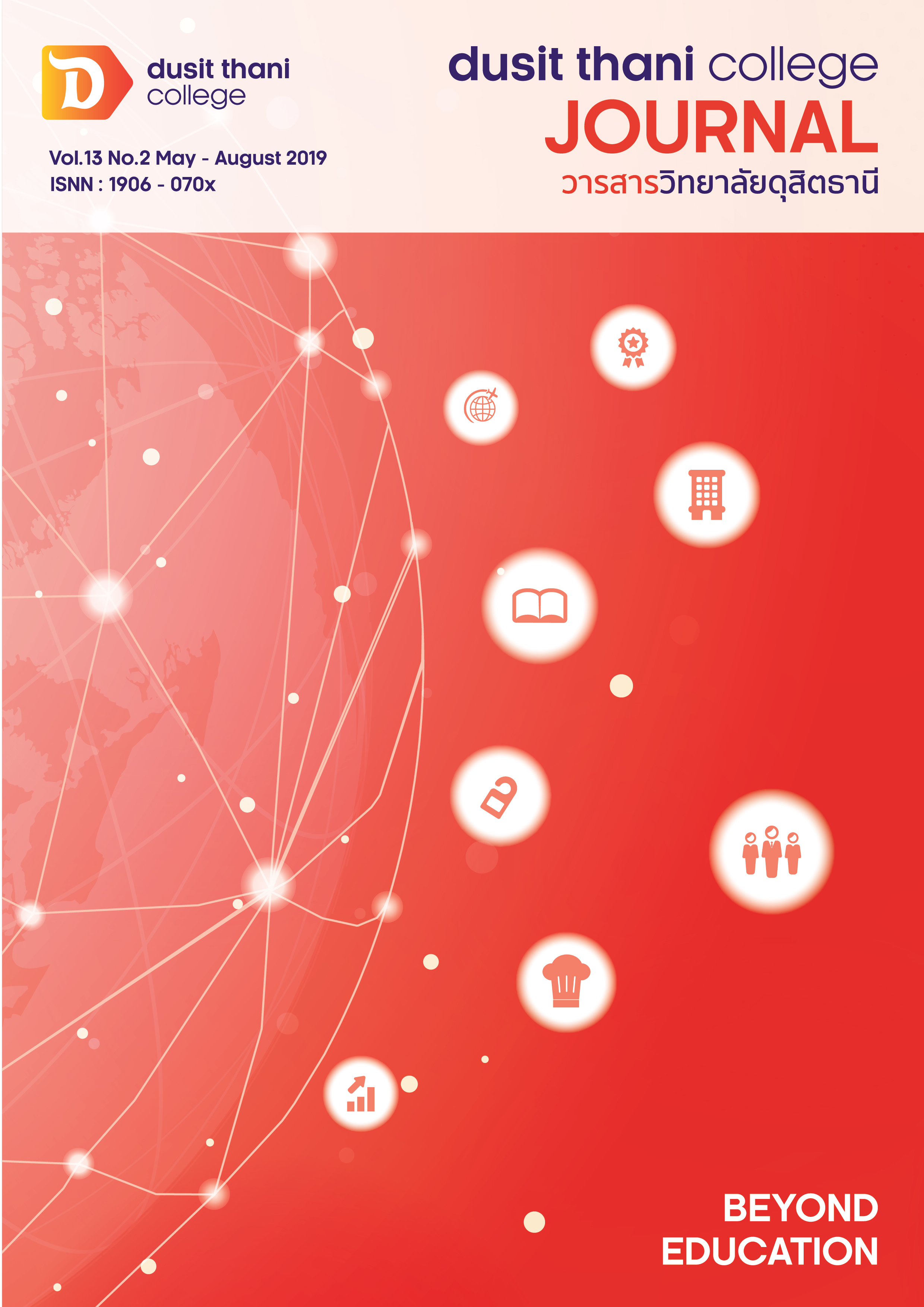แนวทางการพัฒนาความผูกพันของพนักงานในองค์กร
Main Article Content
บทคัดย่อ
คนเป็นทรัพยากรที่มีความสำคัญที่สุดในองค์การ และเป็นปัจจัยสำคัญที่ทำให้องค์การขับเคลื่อนไปสู่ความสำเร็จ แนวคิดเรื่องการบริหารทรัพยากรมนุษย์ให้เปี่ยมไปด้วยพลังหรือปลดปล่อยศักยภาพของมนุษย์ที่ไม่มีที่สิ้นสุดออกมา (Workforce Enrichment) จึงกลายเป็นกลยุทธ์สำคัญในการสร้างความได้เปรียบในการแข่งขันในโลกธุรกิจ โดยเฉพาะอย่างยิ่งการมุ่งสร้างพลังที่เกิดจากความผูกพันของพนักงาน (Employee Engagement) ซึ่งจะทำให้พนักงานเกิดความมุ่งมั่นและอุทิศตนเพื่อความสำเร็จขององค์การ คุณลักษณะดังกล่าวสามารถสร้างได้ด้วยปัจจัยหลายประการ อาทิ การกำหนดค่านิยมร่วมกันของพนักงาน การพัฒนาคุณภาพชีวิต การปรับลักษณะงานให้มีความท้าทายและน่าสนใจ การส่งเสริมความสัมพันธ์ในงาน การดูแลผลประโยชน์ตอบแทน การพัฒนาโอกาสความก้าวหน้า และการพัฒนาภาวะผู้นำ เป็นต้น
Article Details
รูปแบบการอ้างอิง
ธรรมวิริยะวงศ์ ป. . . (2020). แนวทางการพัฒนาความผูกพันของพนักงานในองค์กร . วารสารวิทยาลัยดุสิตธานี, 13(2), 493–504. สืบค้น จาก https://so01.tci-thaijo.org/index.php/journaldtc/article/view/241088
ประเภทบทความ
บทความวิชาการ
นโยบายการพิจารณากลั่นกรองบทความ
- บทความวิจัยและบทความวิชาการทุกเรื่องที่จะได้รับการตีพิมพ์ต้องผ่านการพิจารณากลั่นกรองโดยผู้ทรงคุณวุฒิ (Peer Review) ในสาขาที่เกี่ยวข้อง จำนวน 3 ท่าน/บทความ
- บทความ ข้อความ ภาพประกอบและตารางประกอบที่ลงตีพิมพ์ในวารสารเป็นความคิดเห็นส่วนตัวของผู้เขียน กองบรรณาธิการไม่จำเป็นต้องเห็นด้วยเสมอไป และไม่มีส่วนรับผิดชอบใด ๆ ถือเป็นความรับผิดชอบของผู้เขียนแต่เพียงผู้เดียว
- บทความที่จะได้รับการตีพิมพ์จะต้องไม่เคยตีพิมพ์ เผยแพร่ที่ใดมาก่อน และไม่อยู่ระหว่างการพิจารณาของวารสารฉบับอื่น หากตรวจสอบพบว่ามีการตีพิมพ์ซ้ำซ้อน ถือเป็นความรับผิดชอบของผู้เขียนแต่เพียงผู้เดียว
- บทความใดที่ผู้อ่านเห็นว่าได้มีการลอกเลียนหรือแอบอ้างโดยปราศจากการอ้างอิง หรือทำให้เข้าใจผิดว่าเป็นผลงานของผู้เขียน กรุณาแจ้งให้กองบรรณาธิการวารสารทราบจะเป็นพระคุณยิ่ง
เอกสารอ้างอิง
1. Bunjongkaew,Thanyaluck. (2005). Organizational Commitment :Case Studyof Revenue Bangkok AreaRegion7 Office Master ofArts in Politica ScienceRamkhamhaengUniversity.
2. Davis, K. & Newstom, J.W. (1989).Human behavior at work :Organization behavior. 8thed. New York : McGraw-Hill.
3. Duongsawang, Kritsadakorn. (1997).Organizational Commitment in the petroleum business. Master Thesis Business Administration Kasetsart University.Jenkins, S. and Delbridge, R.(2013) “Context Matters : Examining ‘Soft’ and ‘Hard’ Approches to Employee Engagement in Two Workplaces”. International Journal of Human Resource Management, 24, 14:2670-91.
4. Mungkata, Kritsada. (2005). Factors AffectingEngagement to School of Teachers in Schools under The Office of Khon Kaen Educational Service Area, Region 1. Master Thesis of Education Faculty of Management Studies Loei Rajabhat University.
5. Punti, Mongkol. (2004). FactorsAffecting Engagement : A Case Study of Police Officers of Police Station. Chiang Dao DistrictChiangmai Province.Independent Study Master of Public Administration Human ResourceManagement Chiang MaiUniversity.
6. Puapongpunt, Wanlapa. (2004). FactorsAffecting EngagementOrganization of Specialized Staff of CATTelecom Public Company Limited. Public and PrivateManagement NationalInstitute of Development Administration.
7. Serirat, Siriwan. , Hirunkitti, Somchai.and Tungsinsupsiri, Thanawat. (2007) Management andOrganizational Behavior.Bangkok : Teera Film andCytec.
8. Shuck, B., Reio, T. and Rocco, T. (2011) “Employee Engagement : An Antecedent and Outcome Approach to Model Development, Human Resource Development International, 14,4 : 427-45.
9. Simachokdee, Witul. (1996). Government Reform andManagement Government :
A Reengineering and Reinventing Handbook for the Public Sector. Bangkok:
Noble Media.
10. Siriwut, Pannee. (2005). The Study of OrganizationalCommitment Employeesof Phinix Pulp and Pur Public Company Limited,Lam Nam Phong District Khon Kaen Province. Master Thesis EducationalAdministration in LoeiRajabhat University.
11. Soane, E., Truss, C., Alfes, K., Shantz, A., Rees, C. and Gatenby, M. (2012) “Development and Validation of a New Measure of Employee Enagagement : The ISA Engagement Scale”, Human Resource Development International, 15, 5 : 529-47.
12. Stairs, M. and Galpin, M. (2011) “Positive Engagement : From Employee Engagement to Workplace Happiness”. In P. Linley, S. Harrington and N. Garcca (eds) Oxford Handbook of Positive Psychology and Work. Oxford : Oxford University Press
13. Tansakul, Somchit. (2005). Organizational Commitment. Pharmacy salesman. Masterof Arts Thesis Department ofSocial Sciences for Development Chandrakasem RajabhatUniversity.
14. Truss, C., Mankin, D. and Kelliher, C. (2012) Strategic Human Resource Mangement. Oxford : Oxford University Press.
15. ____, Alfes, K., Delbridge, R. Shantz, A. and Soane,E. (2013) “Employee Engagement, Organizational Performance and Individual Wellbeing : Development the Theory, Exploring the Evidence, editorial introduction to special issue, International Journal of Human Resource Management, 24, 14 : 2657-69.
16. Wollard, K. and Shuck, B. (2011) “Antecedents to Employee Engagement : A Structured Review of the Literature”. Advances in Developing Human Resource, 13, 4:429-46.
2. Davis, K. & Newstom, J.W. (1989).Human behavior at work :Organization behavior. 8thed. New York : McGraw-Hill.
3. Duongsawang, Kritsadakorn. (1997).Organizational Commitment in the petroleum business. Master Thesis Business Administration Kasetsart University.Jenkins, S. and Delbridge, R.(2013) “Context Matters : Examining ‘Soft’ and ‘Hard’ Approches to Employee Engagement in Two Workplaces”. International Journal of Human Resource Management, 24, 14:2670-91.
4. Mungkata, Kritsada. (2005). Factors AffectingEngagement to School of Teachers in Schools under The Office of Khon Kaen Educational Service Area, Region 1. Master Thesis of Education Faculty of Management Studies Loei Rajabhat University.
5. Punti, Mongkol. (2004). FactorsAffecting Engagement : A Case Study of Police Officers of Police Station. Chiang Dao DistrictChiangmai Province.Independent Study Master of Public Administration Human ResourceManagement Chiang MaiUniversity.
6. Puapongpunt, Wanlapa. (2004). FactorsAffecting EngagementOrganization of Specialized Staff of CATTelecom Public Company Limited. Public and PrivateManagement NationalInstitute of Development Administration.
7. Serirat, Siriwan. , Hirunkitti, Somchai.and Tungsinsupsiri, Thanawat. (2007) Management andOrganizational Behavior.Bangkok : Teera Film andCytec.
8. Shuck, B., Reio, T. and Rocco, T. (2011) “Employee Engagement : An Antecedent and Outcome Approach to Model Development, Human Resource Development International, 14,4 : 427-45.
9. Simachokdee, Witul. (1996). Government Reform andManagement Government :
A Reengineering and Reinventing Handbook for the Public Sector. Bangkok:
Noble Media.
10. Siriwut, Pannee. (2005). The Study of OrganizationalCommitment Employeesof Phinix Pulp and Pur Public Company Limited,Lam Nam Phong District Khon Kaen Province. Master Thesis EducationalAdministration in LoeiRajabhat University.
11. Soane, E., Truss, C., Alfes, K., Shantz, A., Rees, C. and Gatenby, M. (2012) “Development and Validation of a New Measure of Employee Enagagement : The ISA Engagement Scale”, Human Resource Development International, 15, 5 : 529-47.
12. Stairs, M. and Galpin, M. (2011) “Positive Engagement : From Employee Engagement to Workplace Happiness”. In P. Linley, S. Harrington and N. Garcca (eds) Oxford Handbook of Positive Psychology and Work. Oxford : Oxford University Press
13. Tansakul, Somchit. (2005). Organizational Commitment. Pharmacy salesman. Masterof Arts Thesis Department ofSocial Sciences for Development Chandrakasem RajabhatUniversity.
14. Truss, C., Mankin, D. and Kelliher, C. (2012) Strategic Human Resource Mangement. Oxford : Oxford University Press.
15. ____, Alfes, K., Delbridge, R. Shantz, A. and Soane,E. (2013) “Employee Engagement, Organizational Performance and Individual Wellbeing : Development the Theory, Exploring the Evidence, editorial introduction to special issue, International Journal of Human Resource Management, 24, 14 : 2657-69.
16. Wollard, K. and Shuck, B. (2011) “Antecedents to Employee Engagement : A Structured Review of the Literature”. Advances in Developing Human Resource, 13, 4:429-46.


